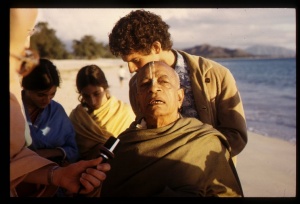SB 10.1.8: Difference between revisions
(Vanibot #0018 edit: make synonym terms in Sanskrit italic in SB - Vanisource) |
(Vanibot #0054 edit - transform synonyms into clickable links, which search similar occurrences) |
||
| Line 23: | Line 23: | ||
<div class="synonyms"> | <div class="synonyms"> | ||
''rohiṇyāḥ'' | ''[//vanipedia.org/wiki/Special:VaniSearch?s=rohiṇyāḥ&tab=syno_o&ds=1 rohiṇyāḥ]'' — of Rohiṇīdevī, the mother of Baladeva; ''[//vanipedia.org/wiki/Special:VaniSearch?s=tanayaḥ&tab=syno_o&ds=1 tanayaḥ]'' — the son; ''[//vanipedia.org/wiki/Special:VaniSearch?s=proktaḥ&tab=syno_o&ds=1 proktaḥ]'' — is well known; ''[//vanipedia.org/wiki/Special:VaniSearch?s=rāmaḥ&tab=syno_o&ds=1 rāmaḥ]'' — Balarāma; ''[//vanipedia.org/wiki/Special:VaniSearch?s=saṅkarṣaṇaḥ&tab=syno_o&ds=1 saṅkarṣaṇaḥ]'' — Balarāma is none other than Saṅkarṣaṇa, the first Deity in the quadruple group (Saṅkarṣaṇa, Aniruddha, Pradyumna and Vāsudeva); ''[//vanipedia.org/wiki/Special:VaniSearch?s=tvayā&tab=syno_o&ds=1 tvayā]'' — by you (it is so said); ''[//vanipedia.org/wiki/Special:VaniSearch?s=devakyāḥ&tab=syno_o&ds=1 devakyāḥ]'' — of Devakī, the mother of Kṛṣṇa; ''[//vanipedia.org/wiki/Special:VaniSearch?s=garbha&tab=syno_o&ds=1 garbha]-[//vanipedia.org/wiki/Special:VaniSearch?s=sambandhaḥ&tab=syno_o&ds=1 sambandhaḥ]'' — connected with the womb; ''[//vanipedia.org/wiki/Special:VaniSearch?s=kutaḥ&tab=syno_o&ds=1 kutaḥ]'' — how; ''[//vanipedia.org/wiki/Special:VaniSearch?s=deha&tab=syno_o&ds=1 deha]-[//vanipedia.org/wiki/Special:VaniSearch?s=antaram&tab=syno_o&ds=1 antaram]'' — transferring bodies; ''[//vanipedia.org/wiki/Special:VaniSearch?s=vinā&tab=syno_o&ds=1 vinā]'' — without. | ||
</div> | </div> | ||
Latest revision as of 18:19, 17 February 2024

A.C. Bhaktivedanta Swami Prabhupada
TEXT 8
- rohiṇyās tanayaḥ prokto
- rāmaḥ saṅkarṣaṇas tvayā
- devakyā garbha-sambandhaḥ
- kuto dehāntaraṁ vinā
SYNONYMS
rohiṇyāḥ — of Rohiṇīdevī, the mother of Baladeva; tanayaḥ — the son; proktaḥ — is well known; rāmaḥ — Balarāma; saṅkarṣaṇaḥ — Balarāma is none other than Saṅkarṣaṇa, the first Deity in the quadruple group (Saṅkarṣaṇa, Aniruddha, Pradyumna and Vāsudeva); tvayā — by you (it is so said); devakyāḥ — of Devakī, the mother of Kṛṣṇa; garbha-sambandhaḥ — connected with the womb; kutaḥ — how; deha-antaram — transferring bodies; vinā — without.
TRANSLATION
My dear Śukadeva Gosvāmī, you have already explained that Saṅkarṣaṇa, who belongs to the second quadruple, appeared as the son of Rohiṇī named Balarāma. If Balarāma was not transferred from one body to another, how is it possible that He was first in the womb of Devakī and then in the womb of Rohiṇī? Kindly explain this to me.
PURPORT
Here is a question particularly directed at understanding Balarāma, who is Saṅkarṣaṇa Himself. Balarāma is well known as the son of Rohiṇī, yet it is also known that He was the son of Devakī. Parīkṣit Mahārāja wanted to understand the mystery of Balarāma's being the son of both Devakī and Rohiṇī.